The legends preceded it: chocolate so dark it ceased to taste like chocolate. Chocolate so intense it required cautionary statements. Chocolate so fine it cost $32 per pound. One of my coworkers is a fan of dark chocolate, and he was the one who first told me about the 99%-cocoa Lindt chocolate bar.
Such purity is exceptionally rare. A normal Hershey bar is rumored to contain about 11% cocoa (and could get worse). The “Special Dark” Hershey bar is just 45% cocoa. Even the “Extra Dark” variant clocks in at only 60%. Connoisseurs must look to a more exotic manufacturer.
The Lindt Excellence line of fine chocolate bars is widely available in the United States. Dark chocolate versions with 85% cocoa can be found with relative ease at chains as plebeian as Target. Such ubiquity is not shared by the 99% bar. For it, one must travel to a Lindt chocolate store. One exists in the Mall of America.
At the store, I was greeted by two pleasant young women offering free chocolate samples to browsers. My goal clear, I declined their truffles and proceeded straight to the chocolate bar section. There, on the wall, I saw it: a 99%-pure bar of cocoa. One of the saleswomen regarded my choice with concern. She made sure that I knew what I was getting into, that I knew I should enjoy the bar slowly, at home, with proper reverence and plenty of water. Undeterred by the cautionary statements, I asserted my comfort with the chocolate and completed my purchase. On the way home, I picked up a more mundane 85% bar for comparison.
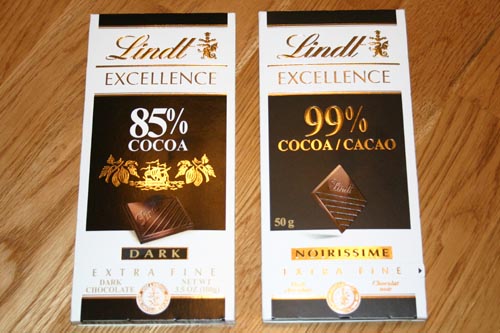
The first thing I noticed was that the 99% bar was smaller than the 85% bar. Although the external packages shared identical dimensions, the 99% bar had a net weight of only 50 grams — half that of the 85% bar. That smaller size was not reflected in the price, for the 99% bar cost 10% more than the 85% bar, or 120% more by weight. The ingredient lists were very similar (chocolate, cocoa powder, cocoa butter, and sugar), but the 85% bar contained vanilla while the 99% bar had none. Both were made in France — odd, seeing as how Lindt is a Swiss company.

I carefully opened the cardboard shell of the 99% bar and pulled out a foil tray. I was more than a bit surprised to find warnings on the wrapper that instructed me to work my way up to the 99% bar via the 70% and 85% versions.
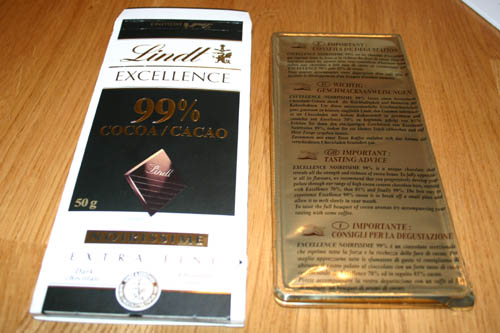
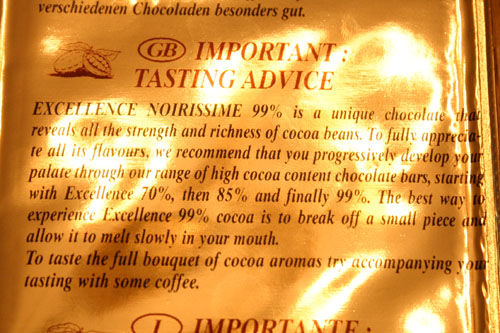
Not wanting to disobey a piece of foil, I pulled out my 85% bar and warmed up my palate with a few nibbles. Suitably prepared, I returned to the main event.
The remainder of the foil warning cautioned the consumer to limit indulgence to small pieces left to melt on one’s tongue. Oddly, that part of the warning existed only in the English and German versions of the instructions. Perhaps the French and Italians are naturally better versed in the art of chocolate appreciation.
I took a deep breath and peeled back the wrapper from the fancy tray. Inside was a thin wafer of the darkest chocolate I have ever seen. I cautiously broke off a square, an act reported with a crisp snap. Ready to experience Chocolate Zen, I closed my eyes and laid the square on my tongue. My mouth closed, and my body heat began to release the essence of the bar.
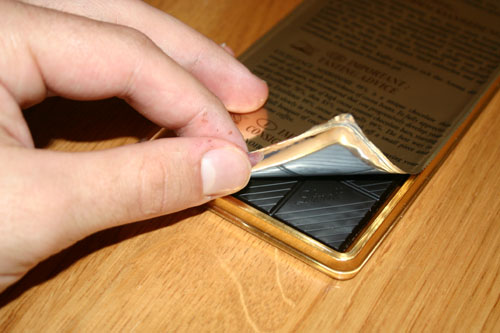
I was at first struck by a mild bitterness, but that quickly passed (and was not to return for the rest of the session). The super-dark chocolate melted quickly and imparted a decidedly creamy mouthfeel, not unlike a fine caramel. Perhaps the most surprising trait was the absence of chocolate flavor, at least not in the traditional sense. The confection was not tasteless — no, it was simply unlike any chocolate I had ever experienced. Even the 85% bar was a world apart.
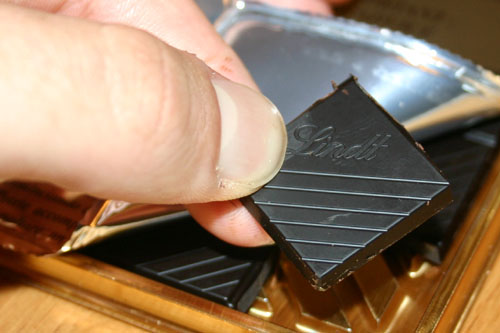
The 99% chocolate was an experience of purity. No chemical aftertaste. No waxy mouthfeel. Nothing to distract from the singular cocoa focus.
To compare the 99% bar with a Hershey’s dark bar would be to insult the Lindt creation, for they exist not in the same realm. Whereas the Hershey’s bar is overtly bitter and artificial, the 99% cocoa is soothing and natural. Neither are very sweet, but while the Hershey’s bar longs for sugar, the Lindt imparts an air of balance in its lack.
I sampled the 85% and 99% bars in turn several times, exploring different consumption techniques and speeds. All methods were enjoyable in their own ways.
After consuming just three squares of the 99% bar, I felt it was time to bring the experience to an end. The richness of the chocolate was leaving me satiated, and I didn’t want to waste either bar when I was not in the proper mindset for full enjoyment of the act.
If you get the opportunity to try high-quality, high-purity chocolate, I recommend that you indulge. If nothing else, you will gain a new appreciation for the rift between American commodity chocolate and what is possible from the world’s elite chocolatiers.







Recent Comments